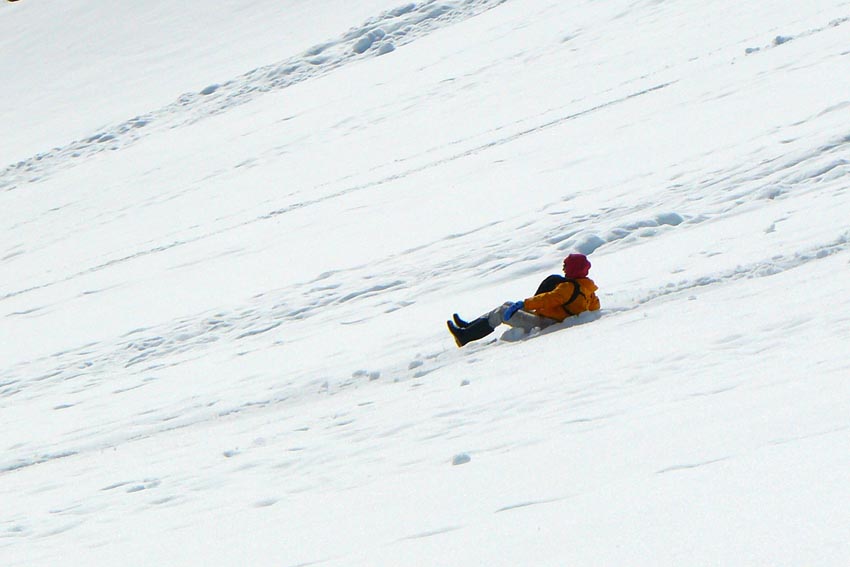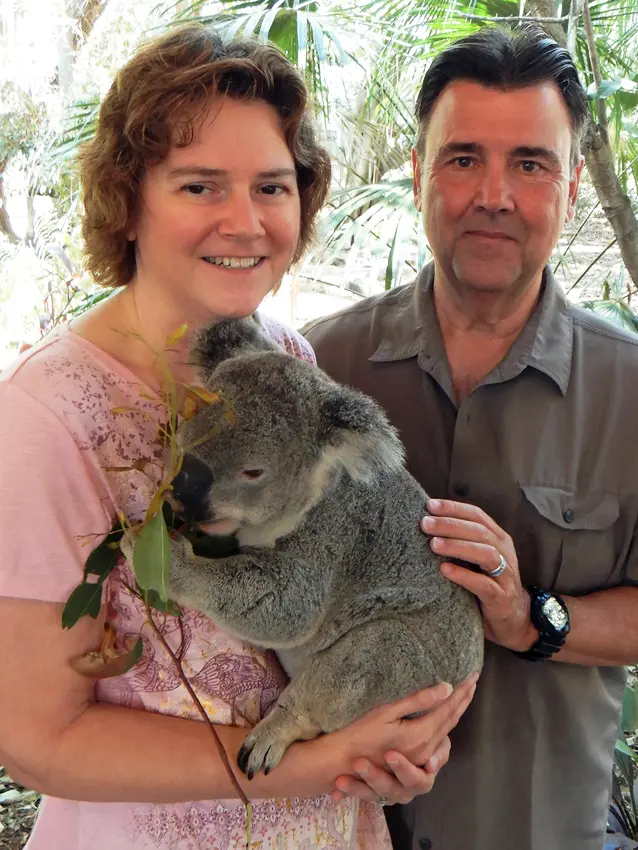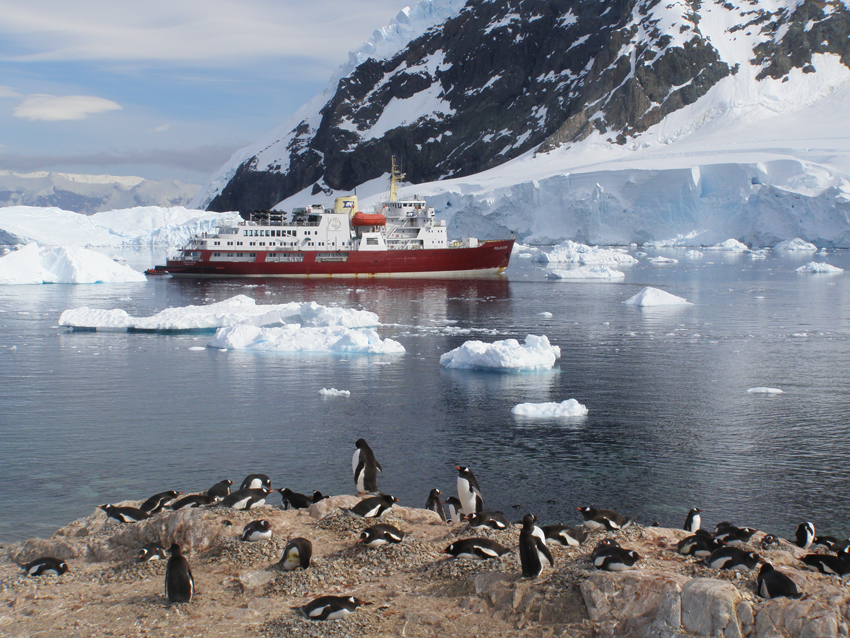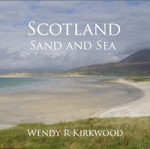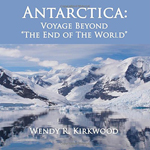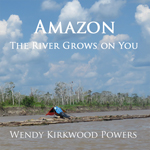Last Updated on May 20, 2020 by PowersToTravel
This is an excerpt from my book describing my experiences aboard the M/V Polar Star from Ushuaia to Antarctica, December 2007. See the column on the right for purchasing information.
Shortly after breakfast we donned our shore attire, packed our backpacks and camera cases and hurried around the corner to the Wet Room. Navigating the Wet Room was an adventure. The corridor through the Wet Room meandered from the inside hall to the outside bulkhead, lined with benches, and racks with hooks and hanging life jackets. The process of walking end to end sounds so orderly, however each person needed to sit down on the bench to take off his deck shoes and don his fourteen inch tall rubber Wellies while wearing about four layers (base layer, flannel shirt, fleece jacket and Gortex jacket.) Each person might be carrying a camera case, backpack and perhaps a walking stick. The entire troop of one hundred people was forced to stop. Then each of those one hundred people anxiously tried to push by to find their own particular Wellies to be the first in line for the zodiac boat.
I put it all together and then remembered I forgot to pee, and there are NO facilities ashore in Antarctica. Finally, when I emerged from the Wet Room to stand in the long line along the ship’s port side, I was truly happy that it was thirty-five degrees with a biting wind. I was now ready to tear off all of my layers.
We kept saying “We’ll get there earlier. We don’t want to be last.” But somehow we kept finding ourselves near the end of the crush. I should have approached the call to the Wet Room in the same way I approached the bathroom in the morning. I should have set my alarm for a half hour earlier and thrown Dad out into the hall. Well, perhaps not the latter.
We ducked our heads to go through the bulkhead. Ducking our heads was very important. The first evening aboard, as we entered our first bulkhead I had been concentrating on our paperwork and tickets (ever so important to have those original medical forms – God forbid they not let us board) and promptly whacked my head on the bulkhead.
Duck. There, we are outside, and having to walk through a tray of disinfectant. It is so important in Antarctica that outside substances not be brought into this pristine environment, and important as well that we not take substances from one area to another. There is a lot of concern that there are too many tourists traipsing around Antarctica and possibly contaminating this very important area of scientific research. We had been trained on all of the procedures the night before our arrival in Antarctica during a briefing with required attendance with roll-call. Now we sloshed and stomped our way through the three-foot by three-foot tray of disinfectant.
We waited in line along the outside deck, waiting for our zodiac. The zodiacs fit about eight passengers and the driver. They consist of a metal floor, with a heavy rubber pontoon on either side. The line slowly moved forward; we chatted with other people. Mom took a Christmas picture of Danielle and I. Danielle was one of our “bath-mates” – one of three women who shared the adjacent cabin. Both three-person cabins shared the bath between.
As you have probably figured out, Mom, Dad and I shared our cabin. Danielle was from Jacksonville, Florida and twenty-six years old. She was alone on the trip, not having known any of her roommates previously. She was a lovely person and I had liked her immediately. It was rather strange that I, nineteen years older than her, felt more comfortable in her company than with the other older, more mature women. I do not look my age, I am told, and when I travel with my parents, who also do not look their age, and wear sweats and Gortex, people just assume I haven’t left my twenties.
Ah, at last we were to the top of the gangway. Here was Natasha, clipboard in hand. It was fascinating, all of the strange procedures we followed. Perhaps these procedures were common to all cruises, I don’t know, not ever having been on one before, or perhaps they were particular to Antarctica. In any case, as I passed Natasha I smiled and said “Wendy – 324.” I was in cabin 324. She ticked me off the list as having left the ship. Such a procedure would happen as we arrived back, so they could be sure they had left no one in a snow drift, or down a glacier.
It was actually very relaxing and comforting that I did not have to coordinate or supervise my parents. No “Meet us at the corner in thirty minutes” or chasing after the one who forgot what time it was. Usually it’s as if we three are connected by bungee cords. When one is somewhere the others are usually somewhere else. Getting the three of us together in one place in order to move on can be very difficult at times. Ah, the freedom to simply get in a zodiac, and not concern myself where Mom and Dad were. The ship’s crew would supervise them and get them safely back.
Natasha was Russian. A lot of the housekeeping and maintenance staff and sailors were Filipino. The doctor was Swedish. The Expedition Leader was English. The Captain and bridge officers were Polish. They posted a chart on the bulletin board telling us how many of the ship’s guests and staff were of what nationality. It appeared there were about 40% American, 30% English and her former colonies and 30% of various other countries. There was a couple from Japan who spoke little English who were on their honeymoon. There was an organized trip of about eight Germans who had a personal German-speaking guide. There were about eight people from India on a family reunion. The mother always looked so cold. I’m from Massachusetts.
The zodiac ride was quick to the shore that day. As we approached, the driver instructed us to listen carefully to the Landing Master. Each landing was complete with instructions from the Landing Master, usually Hannah or Pierre the Oceanographer and each landing was different. Swing your legs to the right…swing your legs to the left…step on the rocks…don’t step on the rocks…immediately leave the coast line…put your life jackets in the bag…don’t step on the penguin…avoid the seals…take the hike to the left…Sonja has found a seal to the left. It was hard to take it all in.
On this particular day we were landing on a shallow rocky shoreline not too far from a calving glacier. There was danger that if it calved too largely it might cause a small tidal wave that could catch people on shore. We were instructed to immediate move away from the zodiacs up to the large white life preserver bags before removing our life jackets. So we did, as did everyone else.
As a rule, most people did exactly what they were told to, when they were told, with no grumbling. I had not thought previously about the people I would meet on the trip, thinking only of the ship itself and Antarctica. However, it is an unusual breed of people who traipse to the “End of the World,” and spend thousands of dollars to see Ice and Penguins. (“End of the World” is the nickname of the town Ushuaia in Argentina from which the ships leave.) I can’t say that they were “like me,” after all, what the heck does that mean?, but the people for the most part were very friendly, interesting and interested. They graciously did as they were told.
Quickly we moved on from the landing site. This was an unusual sort of location. By the shore a penguin colony clustered around an old Argentinean hut. A long diagonal trail led through the deep snow to a ridge, then along the ridge to a rocky outcropping.
There had been previous landings with hiking options. Our first landing on Yalour Island had included a hike to an elevation and I had eagerly followed my father. Eagerly I trod up about two steps when I found that each step might or might not result in plunging to my knees in snow. A thin layer of ice coated the top of the snow. The lighter weight individuals could possibly walk on top, but the heavier ones plunged down with each step. If previously there had been many people at a location, we could walk in their footsteps, but surprisingly that was seldom the case. This was the end of December, relatively early in the season, and I believe that some of our earlier stops were at locations not much frequented.
That first day on Yalour I plunged my way up the hill, gasped for breath, saw the view, took my photographs and then plunged back. I barely had time to visit the Weddell Seal stretched out near the shoreline. I resolved that the next time I wouldn’t waste my time trudging around, but would stay close to shore and commune with the penguins and seals.
Other people took the hiking option every time and seemed to glory in the experience. Perhaps because I had my digital camera with my 10x zoom I found so much more to photograph without going the long distances. The previous day, Christmas Eve, we had been offered a hike up Spigot Peak – about one thousand feet. Just the thought of climbing that spigot-shaped rock frightened me.
Mom, Dad and I had opted for the long zodiac cruise, thinking we would find some more seals. However, we hadn’t paid close attention to the announcement regarding the Chinstrap Penguin colony which was located in the saddle of the mountain, before the really difficult haul to the top. After a long and cold zodiac ride during which we saw no seals we regretted our decision not to climb.
We did, however, experience the thrill of a calving glacier. As the zodiac circled the edge of the bay, looking for seals at rest we passed close to huge glacier shelves which met the water in the bay. We were perhaps one hundred yards out (give or take a few hundred, as I said, I can’t judge distance!) when it calved. The snow and ice cascaded into the bay, and a small tidal wave raced towards us. John yelled, “Down!” and quickly maneuvered the nose of the zodiac into a position to face the wave. We held our breaths, and held and held. At last we let it out – the little wave was about an inch high when it arrived at our boat. John took that opportunity to lecture us on proper form for dealing with glaciers.
Here I was now, on Christmas Day, thinking, “I’ll make the climb today. The Mikes would be so embarrassed by my wimpy behavior.” (That’s Mike M who once enjoyed hiking one hundred and twenty miles in one week on a vacation, and Mike S who would be embarrassed by me whatever I did.) So I climbed and climbed. And I did make it to the top and it was the most glorious view of the trip. The entire bay was laid out before me, this same bay that had earlier stretched in a semi-circle of mountains around me. The ship floated in a sea of ice flows like a tiny red bathtub toy.
The glacier to the side suddenly calved slightly. We gasped, but no tidal wave flooded the landing site. The penguin colony looked like an anthill from above. It was so warm that many were taking their coats off – that’s people, not penguins. The sun continued to shine brilliantly and the sky remained completely blue.
Florian, our Mountaineering Guide, arrived back at our group on the rock with Joe, our Geologist. “I’ve marked a track up across the glacier. Don’t stray. If you want to follow Joe he will demonstrate why you don’t want to stray.”
Florian was German, and a trained expedition guide. On each landing he was responsible to find the safe route across the ice, mark it with Red Flags, and place Black Flags to mark the danger areas.
The group followed Joe up the glacier further, following the red flagged route. We got to the top and Joe said, “Do not go any further. I’m going further, but I don’t want anyone following me.” He moved ahead about twenty yards and thrust a long fifteen-foot rod into the snow. It stopped, about three feet in. He moved ahead another couple of feet. He thrust the rod in, and in, and in, and never touched bottom. He was standing on the top of a glacial crevasse, and if he fell in, would likely not come out. Why they knew he could stand safely for the demonstration, I didn’t know. I didn’t ask. I did as I was told. I stayed behind the Black Flag.
As we descended the ridge, Florian scouted out a quicker descent for those who were willing – an almost vertical snowy body surf to the bottom. I thought, “What the heck. I’ve already stepped out of my character and climbed this ridge, why not go all the way… down?” I moved off the path which Dad was gently trotting along, and joined about twenty other people huddled nervously at the top of a small precipice. We were instructed to take off our backpacks and wear them in reverse, on our fronts, since we would be glissading. At the time I did not know I would be glissading. Glissading is a term used by the snow and ski enthusiasts, of which I am not one. I just knew that I would be going quickly down a mountain on my buns. Of course, I did as I was instructed and repositioned my backpack.
Gradually the line moved forward. The screams of the leapers flowed up the ridge. I edged closer and closer. As I stood second in line, the current surfer threw herself down the now deepened groove, but got stuck at the very top of the near vertical run. She screamed and screamed. I seem to remember it was Anita, from Texas.
“JUMP, JUMP,” yelled Florian.
“COME AND GET ME! HELP!” she howled. Finally she pushed herself off, and the entire ship could hear her as she tumbled all the way down the mountain.
My stress level increased. Finally it was my turn. I threw myself into the groove, on my buns and started to slide, clutching my backpack. Just like Anita I got stuck at the lip of the precipice. Oh dear, I wonder if I screamed. I just don’t know. All I know is I finally went down, and as I went down the first part was so vertical I almost snowballed, and as I went down, the entire mountain’s worth of snow went up – up my Gortex pants, up my jacket back into my basest of layers. How it went Up my boots is still a mystery to me. And then to my embarrassment, I got stuck three-quarters of the way down. At last I made my way off the track.
Thank goodness for my backpack. Each day when we landed I would carry my daypack, complete with camera, extra batteries, spare mittens, fresh flannel shirt, spare socks, scarf, granola bars, glucose tablets, juice and water. Everything for any kind of Antarctic emergency. All I had needed to this point in the trip was the juice. Now, covered in snow from the inside out, I sat on a convenient rock and opened my pack. I dried my freezing feet and back with my scarf, put on my spare socks, swapped my flannel shirt, replaced my gloves and eventually warmed up.
It turned out that Mom had been walking down the ridge as I flew over it and caught a full-action shot of me, legs in the air, in pretty good form. Thankfully I wasn’t snowballing at that moment.
What a Christmas Day, and it was only about eleven a.m.
We returned to the Zodiac landing, queued up for a craft and headed back to our ship. This was now our sixth day of our eleven day trip and I felt so much at home. As Lido and his friend grasped me sailor-style to land me on the gangway, I felt as if I were walking in my own front door. However, when I walk in my own front door I don’t have a hostess greet me, and I don’t say “Wendy – 324!” to announce my return, as I did to Natasha at the top of the stairs.
We sloshed through the disinfectant, into the now almost empty Wet Room, tugged off our boots, crammed on our shoes, hung our life jackets and made our way into the corridor. The Wet Room was only around the corner from our own cabin, which was another reason it was so peculiar that we were always near the end of the zodiac boat line. I flopped myself on my bed, exhausted. Thank goodness lunch was soon, and a brief nap would follow.
The daily program told us each day’s schedule of events, so we could be sure to not be late and to pace ourselves. We caught naps when we could. Each day in Antarctica there were two trips ashore, morning and afternoon, and each lasted hours. Early returns were possible, but why return when you could be making friends with another Gentoo penguin?
Excerpt from my book Antarctica: Voyage Beyond “The End of the World” (2007)
Diabetic Travel Tips
All passengers are advised to pack all necessities for a several hour trip off the ship. One of the first briefings emphasized that passengers could not bring anything with a wrapper that could possibly be discarded or lost and spoil the ecosystem. I discussed my needs with the expedition staff, and was quickly granted permission to carry what I needed along with me. I might have been concerned about a need to carry extra insulin, however I wear an insulin pump and always made sure that I had at least 24 hours in my reservoir, and since it is strapped at my waist under my parka, my body heat kept it safe from freezing. Expedition staff had told us that storms can come up out of no-where, and there was always the potential that our return to the ship be delayed. They always landed extra supplies in a boat before landing the passengers. If I did not wear a pump, I’m not sure how I would have secured my insulin? Thoughts?
Related Links
Polar Star Expeditions Sadly, in 2011 the Polar Star hit a rock in Antarctica and its current status is unknown. It’s interesting that their website says nothing about the status of the ship.
CNN article about the accident
Another blogger interested in the fate of the beloved MV Polar Star with more recent information
I can’t wait until the Polar Star is back on her feet, as I would love to go to Greenland with her!

